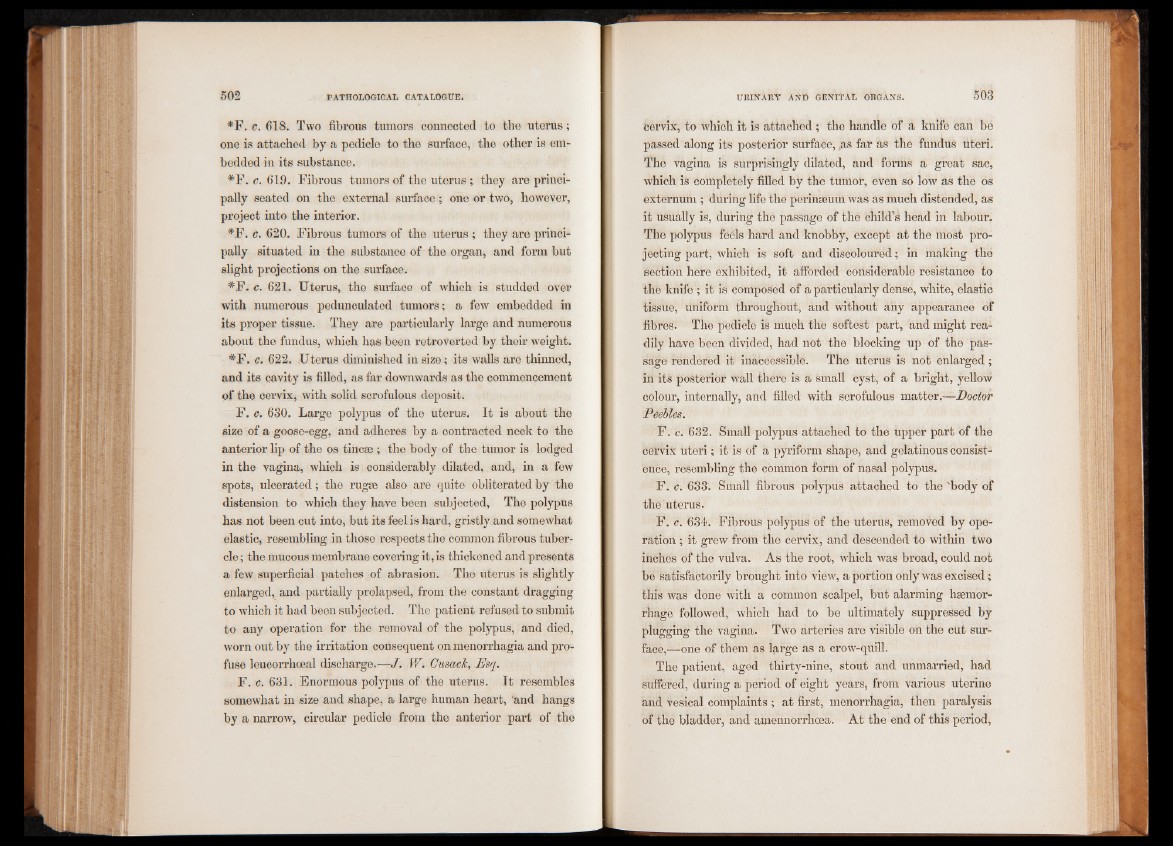
*F. c. 618. Two fibrous tumors connected to the uterus;
one is attached by a pedicle to the surface, the other is embedded
in its substance.
*F. c. 619. Fibrous tumors of the uterus ; they are principally
seated on the external surface; one or two, however,
project into the interior.
*F. c. 620. Fibrous tumors of the uterus ; they are principally
situated in the substance of the organ, and form but
slight projections on the surface.
#F. c. 621. Uterus, the surface of which is studded over
with numerous pedunculated tumors; a few embedded in
its proper tissue. They are particularly large and numerous
about the fundus, which has been retroverted by their weight,
#F. c. 622. Uterus diminished in size; its walls are thinned,
and its cavity is filled, as far downwards as the commencement
of the cervix, with solid scrofulous deposit.
F. e. 630, Large polypus of the uterus, It is about the
size of a goose-egg, and adheres by a contracted neck to the
anterior lip of the os tincse ; the body of the tumor is lodged
in the vagina, which is considerably dilated, and, in a few
spots, ulcerated; the rugae also are quite obliterated by the
distension to which they have been subjected, The polypus
has not been cut into, but its feel is hard, gristly and somewhat
elastic, resembling in those respects the common fibrous tubercle
; the mucous membrane covering it, is thickened and presents
a few superficial patches of abrasion. The uterus is slightly
enlarged, and partially prolapsed, from the constant dragging
to which it had been subjected. The patient refused to submit
to any operation for the removal of the polypus, and died,
worn out by the irritation consequent on menorrhagia and profuse
leucorrhceal discharge.—J. W. Cusack, Esq.
F. c. 631. Enormous polypus of the uterus. It resembles
somewhat in size and shape, a large human heart, "and hangs
by a narrow, circular pedicle from the anterior part of the
Cervix, to which it is attached ; the handle of a knife can be
passed along its posterior surface, .as far as the fundus uteri.
The vagina is surprisingly dilated, and forms a great sac,
which is completely filled by the tumor, even so low as the os
externum; during life the perinseum was as much distended, as
it usually is, during the passage of the child’s head in labour.
The polypus feels hard and knobby, except at the most projecting
part, which is soft and discoloured; in making the
section here exhibited, it afforded considerable resistance to
the knife ; it is composed of a particularly dense, white, elastic
tissue, uniform throughout, and without any appearance óf
fibres. The pedicle is much the softest part, and might readily
have been divided, had not the blocking up of the passage
rendered it inaccessible. The uterus is not enlarged;
in its posterior wall there is a small cyst, of a bright, yellow
colour, internally, and filled with scrofulous matter.—Doctor
Peebles.
F. c. 632. Small polypus attached to thé upper part of the
cervix uteri; it is of a pyriform shape, and gelatinous consistence,
resembling the common form of nasal polypus.
F. c. 633. Small fibrous polypus attached to the 'body of
the uterus.
F. c. 634. Fibrous polypus of the uterus, removed by operation
; it grew from the cervix, and descended to within two
inches of the vulva. As the root, which was broad, could not
be satisfactorily brought into view, a portion only was excised;
this was done with a common scalpel, but alarming haemorrhage
followed, which had to be ultimately suppressed by
plugging the vagina. Two arteries are visible on the cut surface,—
one of them as large as a crow-quill.
The patient, aged thirty-nine, stout and unmarried, had
suffered, during a period of eight years, from various uterine
and vesical complaints ; at first, menorrhagia, then paralysis
of the bladder, and amennorrhcea. At the end of this period,